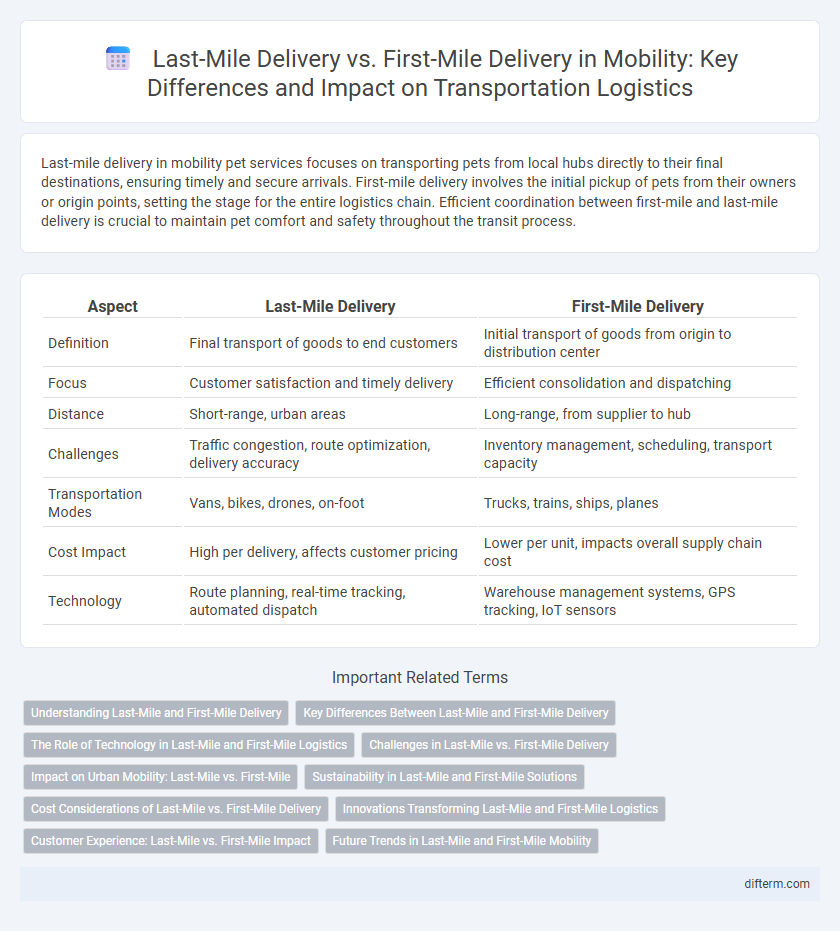Last-mile delivery in mobility pet services focuses on transporting pets from local hubs directly to their final destinations, ensuring timely and secure arrivals. First-mile delivery involves the initial pickup of pets from their owners or origin points, setting the stage for the entire logistics chain. Efficient coordination between first-mile and last-mile delivery is crucial to maintain pet comfort and safety throughout the transit process.
Table of Comparison
| Aspect | Last-Mile Delivery | First-Mile Delivery |
|---|---|---|
| Definition | Final transport of goods to end customers | Initial transport of goods from origin to distribution center |
| Focus | Customer satisfaction and timely delivery | Efficient consolidation and dispatching |
| Distance | Short-range, urban areas | Long-range, from supplier to hub |
| Challenges | Traffic congestion, route optimization, delivery accuracy | Inventory management, scheduling, transport capacity |
| Transportation Modes | Vans, bikes, drones, on-foot | Trucks, trains, ships, planes |
| Cost Impact | High per delivery, affects customer pricing | Lower per unit, impacts overall supply chain cost |
| Technology | Route planning, real-time tracking, automated dispatch | Warehouse management systems, GPS tracking, IoT sensors |
Understanding Last-Mile and First-Mile Delivery
Last-mile delivery involves transporting goods from a distribution hub to the final customer, emphasizing speed and efficiency to meet consumer demands. First-mile delivery focuses on the initial stage of the supply chain, capturing products from manufacturers or suppliers to warehouses, requiring coordination and inventory management. Optimizing both delivery stages enhances overall mobility logistics by reducing costs and improving service quality.
Key Differences Between Last-Mile and First-Mile Delivery
Last-mile delivery involves the final step of transporting goods from a distribution center to the customer's doorstep, emphasizing speed and accuracy to enhance customer satisfaction. First-mile delivery focuses on sourcing products from manufacturers or suppliers to warehouses, prioritizing consolidation and efficiency to reduce initial logistics costs. Key differences include distance covered, with last-mile delivery covering shorter, urban routes, and first-mile delivery managing longer, bulk transportation from origin points.
The Role of Technology in Last-Mile and First-Mile Logistics
Technology enhances efficiency in last-mile delivery by utilizing GPS tracking, route optimization algorithms, and real-time communication platforms to ensure faster and more accurate parcel arrivals. In first-mile logistics, automation tools such as barcode scanning, RFID technology, and warehouse management systems streamline inventory handling and improve shipment accuracy. Both stages leverage IoT devices and data analytics to increase transparency, reduce costs, and enhance overall supply chain responsiveness.
Challenges in Last-Mile vs. First-Mile Delivery
Last-mile delivery faces challenges such as complex urban logistics, traffic congestion, and the high cost of delivery to individual customers, making it less efficient and more expensive than first-mile delivery. First-mile delivery struggles primarily with warehouse consolidation, inventory accuracy, and coordinating shipments from suppliers to distribution centers. Overcoming these challenges requires advanced route optimization, real-time tracking, and investment in automation technologies to improve overall supply chain efficiency.
Impact on Urban Mobility: Last-Mile vs. First-Mile
Last-mile delivery significantly impacts urban mobility by increasing traffic congestion and emissions due to frequent, short-distance trips within dense city areas. First-mile delivery, involving the initial collection of goods from suppliers or warehouses, primarily affects logistics routes outside urban centers with less direct impact on city traffic patterns. Optimizing last-mile delivery through electric vehicles and micro-distribution hubs can reduce environmental footprints and improve overall urban mobility efficiency.
Sustainability in Last-Mile and First-Mile Solutions
Sustainability in last-mile delivery emphasizes reducing carbon emissions through electric vehicles, cargo bikes, and route optimization to lower environmental impact in urban areas. First-mile solutions focus on sustainable sourcing, efficient packaging, and consolidating shipments to minimize waste and energy consumption at the origin of the supply chain. Both stages benefit from innovations in green logistics and smart technology, driving overall eco-friendly mobility in freight transportation.
Cost Considerations of Last-Mile vs. First-Mile Delivery
Last-mile delivery generally incurs higher costs compared to first-mile delivery due to its complexity, involving multiple drop-off points and individualized customer interactions. First-mile delivery benefits from economies of scale, as bulk shipments are consolidated from suppliers to distribution centers, reducing per-unit transportation expenses. Efficient route planning and technology integration in last-mile logistics are critical to mitigating expenses that arise from labor-intensive and time-sensitive operations.
Innovations Transforming Last-Mile and First-Mile Logistics
Innovations transforming last-mile and first-mile logistics include the integration of autonomous delivery vehicles, drone technology, and advanced route optimization algorithms that significantly reduce transit times and operational costs. IoT-enabled tracking systems and AI-driven demand forecasting enhance supply chain transparency and responsiveness, improving the efficiency of both first-mile pickup and last-mile distribution. Sustainable solutions like electric delivery vans and micro-fulfillment centers further revolutionize urban logistics by minimizing environmental impact while accelerating delivery speed.
Customer Experience: Last-Mile vs. First-Mile Impact
Last-mile delivery has a direct impact on customer experience by ensuring timely and accurate package arrival, often shaping final satisfaction and brand perception. First-mile delivery focuses on the efficient collection and initial processing of goods, influencing overall logistics flow and order accuracy. Optimizing both stages enhances reliability, reduces delays, and improves communication transparency for a seamless customer journey.
Future Trends in Last-Mile and First-Mile Mobility
Future trends in last-mile and first-mile delivery are driven by advancements in autonomous vehicles, drone technology, and electric mobility solutions that aim to reduce delivery times and carbon emissions. Integration of AI-powered route optimization and real-time tracking enhances the efficiency and reliability of last-mile deliveries, while smart logistics hubs and urban micro-fulfillment centers improve first-mile operations. Emphasis on sustainable mobility models, including bike couriers and electric cargo bikes, is transforming both first-mile and last-mile delivery landscapes toward greener, more adaptable urban logistics systems.
last-mile delivery vs first-mile delivery Infographic

 difterm.com
difterm.com